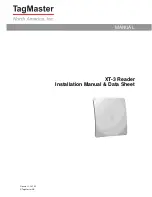
102
CompuScope 82GC
CompuScope 82GC Trigger Output
A Trigger signal is used to synchronize different parts of a measurement system to the same event.
CompuScope 82GC provides a TTL output on one of the front panel connectors. The rising edge of this output
signifies that a trigger event has been detected on the CompuScope 82GC.
In a Master/Slave configuration, only the Trigger Output of the Master card should be used.
For best results, this output should be terminated with a 50
Ω
load capable of absorbing 0.5 Watt power. There
is no output short protection on this signal, so care should be taken in not interfacing it to any output, be it
Ground or any other voltage.
This TTL output is always asserted after a well defined latency inherent in the trigger circuitry. The table shown
below lists the latency for each of the sample rates that the user may select.
Sample Rate
Dual Channel
Latency
Single Channel
Latency
2 GS/s
N/A
84 clocks
1 GS/s
45 clocks
70 clocks
500 MS/s
34 clocks
58 clocks
250 MS/s
30 clocks
56 clocks
200 MS/s
N/A
55 clocks
125 MS/s
28 clocks
N/A
100 MS/s
27 clocks
53 clocks
50 MS/s
25 clocks
N/A
40 MS/s
N/A
50 clocks
20 Ms/s
25 clocks
50 clocks
10 MS/s
25 clocks
N/A
5 MS/s, 2 MS/s,
1 MS/s, 500 kS/s,
200 kS/s, 100 kS/s
24 clocks
N/A
It should be noted that Trigger Output is synchronized to an internal clock, called GCLK, on the
CompuScope 82GC. This clock is not the same as the sampling clock.
The relationship between GCLK and sampling clock must be understood in order to take full advantage of this
powerful feature.
Summary of Contents for CompuScope 14100C
Page 6: ......
Page 24: ...18 Installing CompactPCI PXI Master Slave multi card systems Notes ...
Page 30: ...24 Memory organization on CompuScopes except for CS85GC Notes ...
Page 75: ...Driver installation guide 69 Help About CsTest ...
Page 76: ...70 Driver installation guide Notes ...
Page 90: ...84 CompuScope 85GC Notes ...
Page 174: ...168 Notes Notes ...
















































